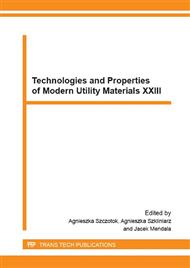[1]
W. Kubiński, M. Kuczera, Hot Bendig of Metal Tubes, Met. Form. 4 (2004) 23-36.
Google Scholar
[2]
W. Kubiński, Hot Bendig of Tubes, Metallurgical Engineering News 12 (2001) 467-471.
Google Scholar
[3]
J. Pacanowski, Z. Kosowicz, Investigation of the effect of the tube bending method on tube elbow distortion, Ores and Non-ferrous Metals 41 (1996) 419-423.
Google Scholar
[4]
PN-EN 10216-2 Standard. Seamless steel tubes for pressure purposes – Technical delivery conditions.
Google Scholar
[5]
A. Hernas, J. Dobrzański, Lifetime and damage of boiler¢s turbine¢s components (in Polish), Publishing House of the Silesian University of Technology, Gliwice, (2003).
Google Scholar
[6]
PN-EN 13480-3 Standard. Metallic industrial piping – Part 3: Desing and calculations.
Google Scholar
[7]
M. Cieśla, J. Tomczak, E. Hadasik, R. Findziński, Geometrical phenomena in tube bending with local induction heating. Proc. of 23rd Int. Conf. on Metallurgy and Materials - Metal 2014, Brno, Czech Republic, May 21-23 (2014).
DOI: 10.4028/www.scientific.net/kem.622-623.717
Google Scholar
[8]
M. Cieśla, J. Tomczak, E. Hadasik, R. Findziński, T. Kawała, Operational characteristics of high-temperaure creep resistant X10CrMoVNb9-1 steel tube bens produced by heat-induction bending, Metallurgical Engineering News 7 (2014) 487-491.
DOI: 10.1515/amm-2015-0314
Google Scholar
[9]
J. Tomczak, Z. Pater et. al, Geometrical phenomena in tube bending with local induction heating, Key Eng. Mat. 622-623 (2014) 717-724.
DOI: 10.4028/www.scientific.net/kem.622-623.717
Google Scholar
[10]
M. Cieśla, R. Findziński, G. Junak, Durability of tube bends made of the 14MoV6-3 steel under low-cycle fatigue conditions and creep at temperature of 500°C, Solid State Phenom 226 (2015) 79-86.
DOI: 10.4028/www.scientific.net/ssp.226.79
Google Scholar
[11]
J. Tomczak, Z. Pater, T. Bulzak, Designing of screw impressions in the helical rolling of balls, Arch. Civ. Mech. Eng. 14 (2014) 104-113.
DOI: 10.1016/j.acme.2013.07.004
Google Scholar
[12]
Z. Pater, J. Tomczak, J. Bartnicki, M.R. Lovell, P.L. Menezes, Experimental and numerical analysis of helical-wedge rolling process for producing steel balls, Int. J. Mach. Tool. Manu. 67 (2013) 1-7.
DOI: 10.1016/j.ijmachtools.2012.12.006
Google Scholar
[13]
A. Stefanik, H. Dyja, S. Mróz, Determination of the critical value of normalized Cockroft – Latham criterion during multi slight rolling based on tensile test, Arch. Metall. Mater. 56 (2011) 545-549.
DOI: 10.2478/v10172-011-0058-0
Google Scholar
[14]
A.S. Wifi, N. El-Abbasi, A. Abdel-Hamid, A study of workability criteria in bulk forming processes, Stud. Appl. Mech. 43 (1995) 333-357.
DOI: 10.1016/s0922-5382(05)80022-4
Google Scholar


